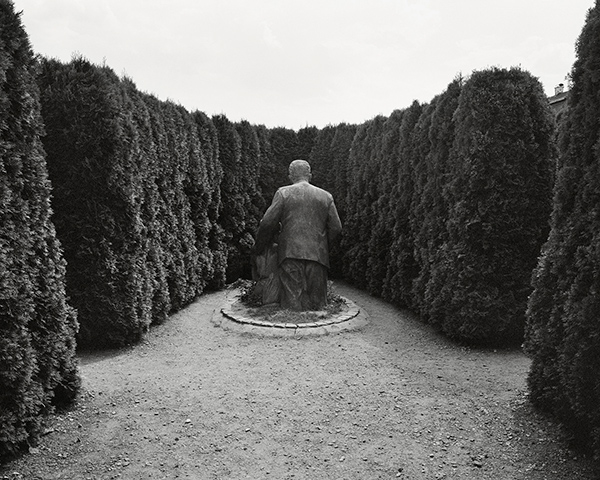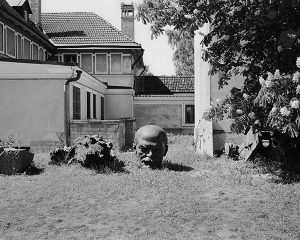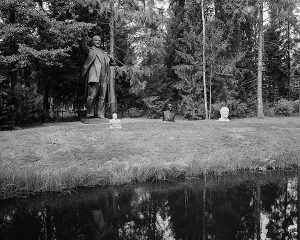Photo prof to exhibit project showing dismantled Soviet statues

Photography professor Matt Moore’s photos of discarded statues of Cold War-era Soviet leaders will be on display at a Portland, Oregon, gallery in May. Shown here is a statue of Joseph Stalin, a leader of the Soviet Union from 1924 to 1953, in the Czech Republic.
September 16, 2021
A Portland, Oregon, art show will showcase the work of an AACC photography professor who took pictures of the dismantled statues of former Soviet leaders whose images were toppled after the collapse of the Communist government in 1991.
Blue Sky Gallery will host the solo exhibition in May. It will feature a selection of the 40-plus photos professor Matt Moore shot in eight countries, including Germany, Poland and the Czech Republic, between 2014 and 2021.
The series, “Post-Socialist Landscapes,” documents where the statues of Joseph Stalin, Vladimir Lenin and others have ended up—often in pieces—and what happened to the sites where they used to stand.

“Sometimes [citizens] melt them down if they’re made out of metal,” said Moore, coordinator of AACC’s photography program. “I’ve seen cases where they’ve been buried in the ground, auctioned off and sold to people that want to collect such things and discarded, dumped behind buildings. In a few cases, there’s been private parks made where people can visit the statues.”
According to Moore, most of the statues in former Soviet republics came down within a two-year span ending in 1991, some by protestors and others by the government.
Moore, the faculty adviser for AACC’s student Photography Club, said his photos tell the story of how societies in the post-Soviet Eastern Bloc dealt with the politics of the Cold War era.
He compared it to the ongoing removal of Civil War statues in the southern United States.
“In that sense, it does inform the conversation over here in terms of what we’re dealing with, with monuments that propagate social injustice and false histories,” Moore said.
But he noted, “It’s not like what’s going on [in the U.S.], where there’s a debate about removing statues. All these [Soviet] statues came down relatively quickly after the fall of the Soviet Union, and that’s because the countries that were being occupied understood that statues have political power and that they’re propaganda.”

He said even the remnants of the statues can feel like a burden for the Russian public.
Moore said his photos expose the visible marks left behind after the statues disappeared from town squares. He called those marks “scars.”
“I’m in search of those scars,” Moore said. “I’m blowing up the idea of a photograph being a moment in time, photographing layers of time, because I’m looking for the idea of disappearance and that something is gone.”
Moore said he was in Prague over the summer to shoot additional photos of statues and locations.
“I go back every summer and keep working on the project and it’s just finally getting to the stage where it’s at now, where I’m ready to finish it,” Moore said. “It’s phenomenal. I love it [because] it’s always an adventure.”
Moore said communities have collected or disposed of the felled statues in different ways.
“A lot of times they’re just sort of discarded, dumped behind buildings,” he said. Statue heads and other parts are on display in some public parks, he said.
Moore said he hopes the photos are informative and aesthetically engaging.
“I think we have a lot to learn from [my photos],” Moore said. “People can look at the work and think about how other cultures have been dealing with this problem.”
His students are learning from the professor’s project.
“I’ve had a more than 20-year career and it has added up to what I teach in the classroom,” Moore said.
Second-year transfer studies student Leighton Greer called Moore’s experience as a photographer “awesome.”
“It’s really cool getting to actually learn, not like off of YouTube, [but] like actually sitting down in a traditional class and learning,” said Greer, a student in Moore’s photography class. She said she is “still learning the basics, but he’s doing a great job teaching that and getting us all familiar.”












Suzanne Spoor • Sep 17, 2021 at 9:29 AM
Matt’s art reminds us that without context, there is no meaning. Seeing these statues–statues that were created and put on pedestals to inspire awe and fear and to exert power–humbled shows how the stories we tell about objects and people are what imbue them with power. I don’t think any individual people should ever, ever be put on pedestals. We should not give any individual that much power over us or over our imaginations.